Wood Pastures Manifesto for Urgent Change to the CAP
Update 10 October 2016: Over 135 European organisations have already shown their support to the Manifesto
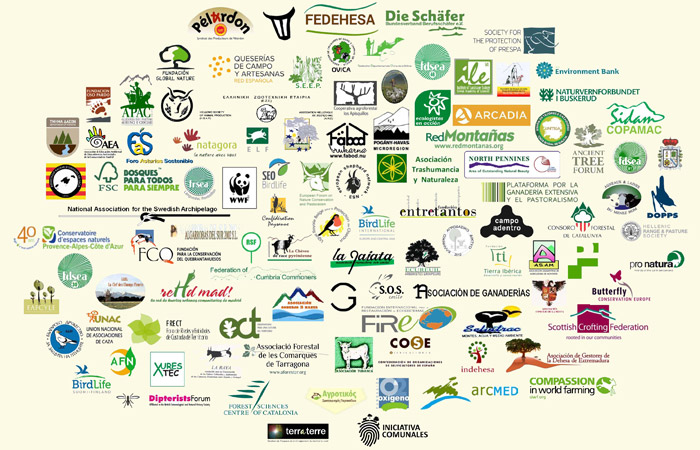
Download the full list of signatories
With the deployment of the new reform of the Common Agricultural Policy (CAP) in 2015, livestock farmers using High Nature Value pastures containing "too many" trees and shrubs are confronted with increased difficulties to receive the much needed EU support for their farming activities.
This latest problem with the CAP poses important threats to the viability of some of our most sustainable livestock farms, and to the biodiversity maintained by such farming systems. EFNCP has warned repeatedly about this issue, with policy seminars, exchanges with the European Commission, reports, and a previous successful Manifesto in 2012.
We feel it is now time to launch a new campaign to raise awareness and gather as much support as possible from organisations across Europe, particularly those working on farming, conservation and rural development, to ask the EU institutions for urgent policy changes.
If you agree with the contents of the Manifesto below, please fill in this form:
- Download the Manifesto (pdf)
- Descárgate el Manifiesto en español (pdf)
- Téléchargez la Pétition en français (pdf)
- Positionspapier herunterladen (pdf)
TEXT OF THE MANIFESTO
The Common Agricultural Policy must stop discriminating against wood pastures - our most environmentally valuable farmland is being condemned to a slow death by EU bureaucracy
Not all pastures are just grass. In many regions of Europe, pastures are enriched by more diverse vegetation, including shrubs and trees. These are known as “wood pastures”. The density of trees in wood pastures varies, ranging from a thinly dispersed cover, as in parklands, to a complete tree canopy with a grazed or harvested understorey of grass and/or shrubs. Similarly, pastures may have just a scattering of shrubs, or be almost entirely shrubs, as in heather pastures. In fact, many wood pastures are a diverse mosaic of trees, shrubs and grass in varying proportions.
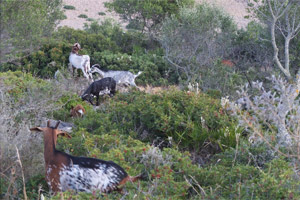
Tree and shrub pastures like these (here including wild olive, lentiscus and myrtle) provide much more forage for goats in summer than the adjacent grass pastures, but are excluded from the CAP due to the density of shrubs (Cádiz, Spain). Photo: Guy Beaufoy.
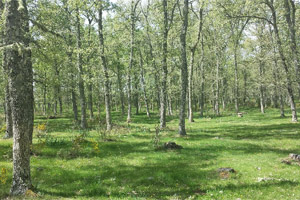
Wood pastures with significant tree cover are frequently considered ineligible for CAP direct payments, irrespective of the fodder value of their understorey. Photo: Carlos Lanchas
Wood pastures cover many millions of hectares of EU farmland and farmers grazing their animals on this land conserve valuable wildlife habitats and reduce the risk of wildfires. In the past they were eligible for support from the Common Agricultural Policy (CAP). But since 2005 the CAP has new and complicated rules that discriminate against pastures with trees and shrubs, incentivising farmers to remove these features that make them so special, to abandon the pastures altogether, or to convert them to forestry use. Such changes lead to a major loss of biodiversity, of valued landscapes and of cultural heritage.
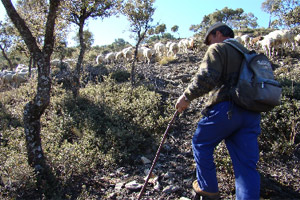
Farmer Pepe Rueda grazing his flock and preventing wildfires on steep, shrubby pastures excluded from CAP support in Andalucía (Spain). Photo: Jabier Ruiz
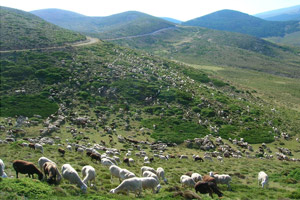
Transhumant flocks graze shrubby vegetation as well as maintaining open grass areas, but the new CAP rules discourage these mosaic pastures, giving priority to 100% grass. Photo: Juan San Vicente
The designers and managers of the CAP in the European Commission treat trees and shrubs on pastures as a sign of abandonment, or of non-productive farming, and their rules and auditors’ inspections make it more difficult for this farmland to receive CAP direct payments. This attitude is unscientific and completely at odds with farming realities in many parts of Europe. It means that large areas of land used for active farming is not considered to be farmland, in opposition to rulings of the European Court of Justice. The rules and the attitude must change to be coherent with the stated aims of the new CAP and of EU environmental policies.
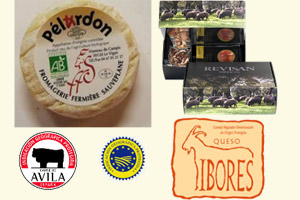
Numerous high-quality meats and cheeses are produced from wood pastures.
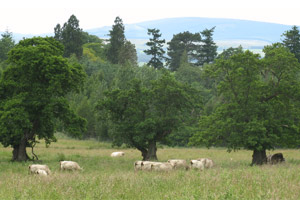
England has chosen to protect its trees in pastures as part of Good Agricultural and Environmental Conditions, which makes them count as part of the eligible area of the pasture, with no limit on tree numbers and no pro-rata reductions in eligibility. Photo: S. Perry
The rules for pastures were changed for the new CAP from 2014, and although there were some improvements on paper, the system also became more complex. DG AGRI auditors are pushing Member States towards increasingly restrictive interpretations of these rules, creating a massive and unnecessary bureaucratic burden and public expense. Instead of supporting the farmers that conserve these special landscapes, the CAP bureaucracy is obsessed with imposing controls on the number of trees and shrubs on the land, adding a loss of environmental public goods to the already excessive administrative expense. For national authorities, the simplest option under this system is to exclude wood pastures from CAP eligibility in order to reduce administrative costs and risks of EU financial penalties.
The CAP should not make direct payments on farmland that is not in active use, whether arable land, grass pasture or wood pasture. But the current rules do not achieve this aim, they merely penalise wood pastures even when in very active use, while allowing arable land and grass pasture to receive payments with no farming activity and just one mechanical intervention per year.
The signatories of this manifesto draw the attention of the EU institutions and Member States to the following facts:
- Wood pastures are genuine, productive farming landscapes, allowing farmers to produce quality meat and milk based on the use of low-input, diversified forage resources. For many farmers making use of wood pastures, they are crucial for the farm economy. Of course, not all woodland is pasture. The differentiating criterion is the usage of the land, not the number of trees - some wood pastures have a high density of trees, much above the EU limit of 100 trees/ha, which has no scientific justification.
- Trees and shrubs on pastures are an important source of forage. Acorns and other fruits provide valuable feed during autumn and early winter; in the dry conditions of southern Europe, the foliage and shoots of trees and shrubs play an essential role in overcoming the lack of grass in summer and early autumn; perennial shrubs and trees are also browsed during the winter, when grass is not available.
- Trees and shrubs have other agronomic functions – they pump nutrients from deep in the soil and thus improve the associated herbaceous pasture, especially on poorer soils. They also extend the grass-growing season into the summer and winter by protecting it from climatic extremes. They provide animals with natural medicines, for example against parasites, thus reducing veterinary costs, and they give protection against meteorological hazards. In a context of climate change, they are a resilient option for many farmers.
- Wood pastures are among the most valuable type of farmland for public goods and ecosystem services, including biodiversity, landscape, carbon storage (both in the vegetation and in the soil), soil protection, water management and cultural values. Ancient trees add special biodiversity and cultural values to wood pastures.
- The environmental importance of wood pastures is confirmed by the classification of some types as Natura 2000 habitats in Annex 1 of the EU Habitats Directive, for example Mediterranean wood pastures with evergreen oaks and Fennoscandian wooded meadows and wooded pastures. Most of the types of Temperate Heaths and Scrub and Sclerophyllous Scrub listed in Annex 1 are pastures with important shrub and/or tree elements, and some of the Semi-natural dry grasslands and Scrubland Facies also include shrubs in the habitat description, as the name suggests.
- These habitats depend on grazing animals to maintain their Conservation Status, and thus to deliver Target 1 of the Biodiversity 2020 strategy. Continued, balanced grazing, and management for regeneration of trees and shrubs, are essential for conserving wood pastures as productive farmland, and as wildlife habitats. Continued grazing of these pastures is also essential for reducing the risk of devastating wildfires over large areas of land, especially in southern Europe.
- Pastures with trees and shrubs are so valuable that the farmers who use and maintain them should have priority for receiving CAP support under a “green” CAP. But in many regions, the way the CAP is designed and implemented is giving these farmers quite the opposite signal, making it difficult for them to claim the direct payments intended for all farmers in the EU, and ultimately condemning wood pastures to a slow death.
- This situation runs directly against the aims of EU environmental policies, especially the Biodiversity Strategy, and makes a mockery of claims that the new CAP is “green” and gives priority to public goods and natural resources.
To save Europe’s wood pastures, we ask the EU institutions and Member States to move urgently to a less bureaucratic and more coherent, common-sense policy for wood pastures, with the following changes:
- All wood pastures in active farming use should be fully eligible for CAP direct payments, in EU regulations and in Member State implementation
- On farmland, trees and shrubs should not be treated a priori as non-productive elements. They should be seen as adding value to farmland, unless they clearly impede farming activity.
- The CAP definition of permanent grasslands/pastures eligible for support should include all pastures and all types of forage in active farming, without requiring special justifications of “established local practices” for pastures that are not predominantly grass, which creates extra administrative burdens and risks of penalties.
- In the interests of CAP simplification, the following clear and straightforward permanent pasture definition is proposed: “land used to grow grasses or other forage (self-seeded or sown) and that has not been ploughed or reseeded for 5 years or longer”.
- In determining eligibility for CAP payments, the actual use of the land should have priority over the type of vegetation. As the European Court of Justice has ruled, the classification of land as “‘permanent pasture’ and, consequently, as ‘agricultural area’, depends on the actual use of the land in question. Thus, an area must be classified as agricultural where it is used as permanent pasture...”
- There should be no arbitrary and unscientific limit for tree numbers on pastures set at EU level and no reductions in eligibility for CAP payments due to the presence of trees and shrubs if there is an acceptable level of farming use. This should be defined by Member States in terms of grazing activity. The state and evolution of vegetation may be used as an indicator of this activity during field inspections, but eligibility should not be determined solely on the basis of remote sensing.
- There should be no unworkable rules, such as the current requirement to distinguish in each field the trees and shrubs that are accessible for grazing “for their full area” (and can be counted as part of the eligible pasture), from those that are not and must be excluded. In many wood pasture systems, trees provide valuable forage from fruits and foliage, without the livestock needing to graze the whole tree. Such basic farming facts must be recognised in the rules and simplifying eligibility criteria for these pastures should be a prime target of efforts to reduce unnecessary CAP bureaucracy.
- Under the current rules, the CAP gives full direct payments on grasslands that are taken out of farming and converted to forestry, but penalises wood pastures, even in active farming. This is completely incoherent and should be changed.
- CAP rules and DG AGRI experts and auditors should recognise the realities and values of actively farmed wood pastures as farmland and should not push Member States to implement eligibility rules that discriminate against them. The EU institutions should safeguard the general principle that support is directed to actively farmed land; what this means at a Member State and regional level should be a matter for subsidiarity.
- An urgent evaluation should be undertaken of the impacts of the new CAP eligibility rules for permanent pastures and of steps to harmonise them with other policy areas
- The actual impacts on the ground of the CAP rules and their implementation, and the full costs and benefits (also in terms of public goods) of the current eligibility control system for pastures should be carefully evaluated.
- The coherence with wider CAP and environmental policy goals should be analysed, together with options for urgently improving the implementing regulations and Commission guidance to Member States, in order to ensure equal treatment for all pasture types and farming systems and to maximise public benefits from direct payments.
- As part of this review, rules and guidance affecting wood pastures under different areas of policy should be harmonised to avoid conflicting messages to farmers at local level, for example conserving woody habitats (Natura 2000) or clearing them (CAP).
- Member states should make full use of rural development programme (RDP) measures for supporting positive management of wood pastures
- RDPs should implement Agri-environment-climate measures for wood pastures across the EU, in order to incentivise active, ecologically sustainable management. A major expansion in such measures is required in southern Member States.
- RDP grants for afforestation of pastures must not be more attractive (economically or in terms of their administrative simplicity) than the available incentives for the continued farming and conservation of wood pastures.


